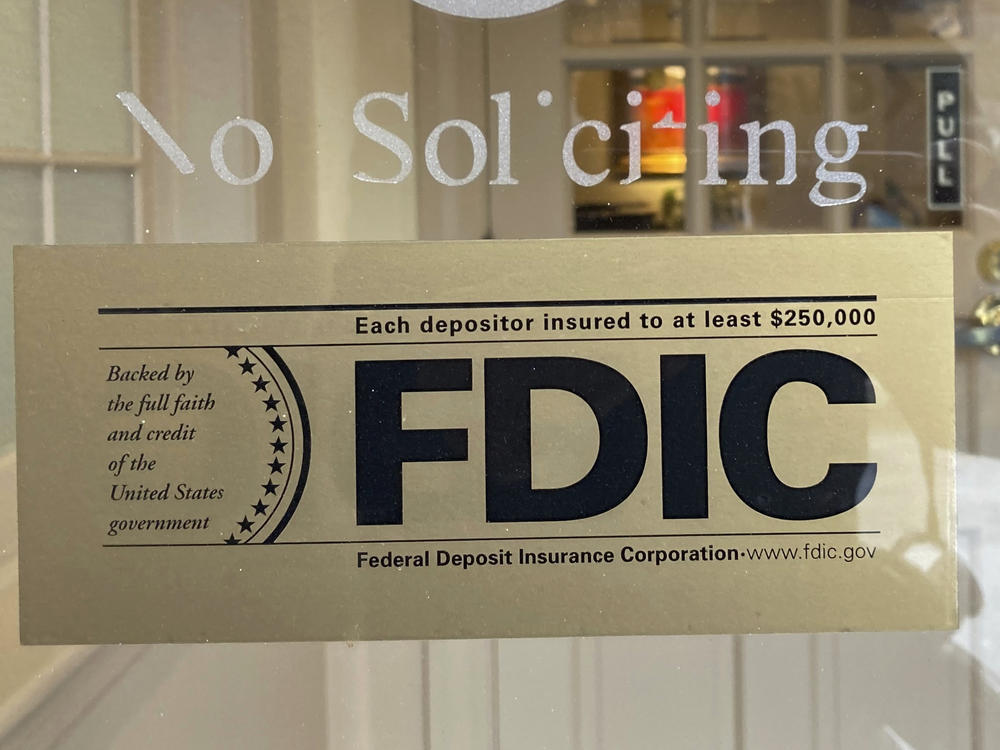Section Branding
Header Content
Will the FDIC's move to cover uninsured deposits set a risky precedent?
Primary Content
For years, the FDIC has insured up to $250,000 of deposits that anyone has stashed away at a federally protected bank. Anything beyond that is not guaranteed to be protected should a financial institution go belly up.
But over the weekend, following the spectacular collapse of Silicon Valley Bank and Signature Bank, the FDIC made an exception to that rule and is now in the process of paying back all customers of the two failed banks in full — no matter the size of their deposits.
The move has renewed a huge debate over government intervention in the banking industry and has raised questions over how the FDIC will operate moving forward should other banks run into trouble.
Here's a rundown of how the FDIC is handling the bank collapse:
How is the FDIC paying SVB and Signature Bank customers back?
Banks pay fees that go into an insurance fund. That fund is what helps pay customers back — up to $250,000 — in the event a bank fails. The FDIC is tapping into this same fund, not money from taxpayers, to pay SVB and Signature Bank customers back in full, including those uninsured portions.
More than 90% of SVB's deposits exceeded the $250,000 insurance cap because most of the bank's customers were tech startups that had deposits in the tens of millions of dollars. The bank did business with nearly half of all U.S. tech startups as well as well known tech companies including Pinterest, Shopify, and the TV streaming provider Roku.
Why does the FDIC have insurance limits when it's clearly able and willing to go beyond that?
The $250,000 limit was designed to keep people from thinking they could always fall back on the government if their financial institutions fall apart.
"It's a question of moral hazard," says Sheila Bair, who ran the FDIC during the 2008 recession. "For wealthier people or companies or large organizations that will have bigger deposits, you want them to look at the bank carefully, kick the tires, make sure it's a safe place."
Regulators say they had to make an exception for Silicon Valley Bank and Signature Bank because there were signs panic was spreading and this was the only way to contain the possibility of a larger run on the banks.
Will the FDIC's exception set a precedent?
Analysts and former Fed officials are concerned that the FDIC's move will reset expectations and leave people under the impression that uninsured depositors — and those who manage those deposits — will ultimately be covered no matter what.
"Depositors no longer have to be aware of the condition of the bank because they know or they have some confidence that they will be paid off, even if they're uninsured," says Thomas Hoenig, former vice chair of the FDIC and former president of the Federal Reserve Bank of Kansas City. "A banker can take greater risk because they can easily raise deposits if people don't worry about whether they're going to get paid back or not."
Hoenig and others say the FDIC has set a new and risky precedent at a precarious moment when inflation is high, interest rates are climbing, and banks with investments in government-backed securities could potentially run into trouble.
The FDIC's move has also sparked a huge debate about when and for whom the government is willing to stage an intervention. Critics view this as a bailout favoring the wealthy, while others argue this intervention was essential and that all deposits, at least for now, must be guaranteed because if people start feeling like their small regional bank is unsafe, it will could ignite broader panic across the financial system.
Is there a sense that other banks are also at risk of failing?
Silicon Valley Bank and Signature Bank were unique in many ways. They were the banks of choice for tech start-ups and companies in the cryptocurrency space, two sectors that have run into trouble in recent months.
Tech and crypto companies started pulling out their deposits as their fortunes soured at the same time these two banks were taking major hits to their investments in long term Treasury bonds. Government bonds are normally safe, but their value declined when interest rates quickly climbed. That put the banks in a squeeze and former Fed officials and regulators wonder if other banks have similarly failed to account for the risks of higher interest rates.
Are there lessons for people or businesses who have large sums of money at a bank?
Let's start with people. If you have under $250,000 sitting in an account at a bank, it is 100% covered by the FDIC under all circumstances. If your deposits exceed that amount — say, after the sale of a house, or if you inherit a large sum of money — then you will want to spread your money around and not keep it in a a single account or at just one bank. Spreading your money means spreading your risk.
For businesses with bigger deposits, analysts say the value of a bank's stock is not a great indicator of stability. Instead they advise scrutinizing a bank's growth rate. Rapid growth may suggest riskier investments. Also, look at whether the bank is making money, how much capital they have, and what kinds of losses they've experienced in the past. If a bank mostly services a particular industry, a downturn in relevant sectors may mean companies will need access to their cash; how much capital a bank has available will be essential in those periods.
.
Copyright 2023 NPR. To see more, visit https://www.npr.org.

